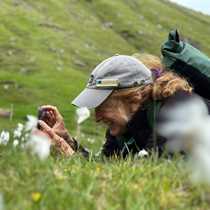Astoria
We woke to the gently, undulating swells of the Pacific Ocean, a force experienced while still on the Columbia River. Heading towards the “Bar,” historically a treacherous area of shifting sands, we could see breakers where the mighty river of the west met the ocean surf. The open Pacific was not our destination so we turned towards the rising sun and the town of Astoria.
At the Columbia River Maritime Museum, a docent walked us through an extensive array of exhibits. From lighthouse prisms to a full-sized Coast Guard emergency rescue boat, the quality and diversity of displays were impressive. While visiting the Museum, we received distressing news. Last night a fire leveled Fort Clatsop, the re-created 1805-06 winter home of the Corps of Discovery. The structure was built in 1955 by the Junior Chamber of Commerce to commemorate the sesquicentennial celebration of the Lewis and Clark Expedition. The cause of the fire has not been determined as yet, but thoughts towards rebuilding are alive, and offers of assistance have started to pour in.
It has been said, “On a clear day you can see forever,” and it certainly seemed that way from the top of Cockscomb Hill, 600 feet above sea level. For those of us that wanted to see a bit beyond “forever,” and amuse ourselves as well, we climbed to the top of the Astoria Column, another 125 feet, and flung balsa wood airplanes skyward. One little plane caught a thermal, spiraled yet higher and seemed to be on its way to the Portland airport.
The weather held calm and sunny for the afternoon, and with that, we headed for Cape Disappointment. The only disappointment to be found there was in the name. Under sunny skies we walked through a spruce and alder filled forest to the Cape’s lighthouse. We could see across the mouth of the Columbia River and out to the Pacific Ocean, cormorants used a nearby cliff as a roost, as evidence by a generous covering of guano. Back at the visitors center, we found a variety of new Lewis and Clark exhibits portraying the Corps’ experiences, discoveries, and hardships. Many displays had interactive elements, inviting us to a hands-on participation.
Back aboard the Seabird, we gathered for the Captain’s Farewell cocktail party and headed east towards Portland, having an opportunity to reflect on our river adventures.
We woke to the gently, undulating swells of the Pacific Ocean, a force experienced while still on the Columbia River. Heading towards the “Bar,” historically a treacherous area of shifting sands, we could see breakers where the mighty river of the west met the ocean surf. The open Pacific was not our destination so we turned towards the rising sun and the town of Astoria.
At the Columbia River Maritime Museum, a docent walked us through an extensive array of exhibits. From lighthouse prisms to a full-sized Coast Guard emergency rescue boat, the quality and diversity of displays were impressive. While visiting the Museum, we received distressing news. Last night a fire leveled Fort Clatsop, the re-created 1805-06 winter home of the Corps of Discovery. The structure was built in 1955 by the Junior Chamber of Commerce to commemorate the sesquicentennial celebration of the Lewis and Clark Expedition. The cause of the fire has not been determined as yet, but thoughts towards rebuilding are alive, and offers of assistance have started to pour in.
It has been said, “On a clear day you can see forever,” and it certainly seemed that way from the top of Cockscomb Hill, 600 feet above sea level. For those of us that wanted to see a bit beyond “forever,” and amuse ourselves as well, we climbed to the top of the Astoria Column, another 125 feet, and flung balsa wood airplanes skyward. One little plane caught a thermal, spiraled yet higher and seemed to be on its way to the Portland airport.
The weather held calm and sunny for the afternoon, and with that, we headed for Cape Disappointment. The only disappointment to be found there was in the name. Under sunny skies we walked through a spruce and alder filled forest to the Cape’s lighthouse. We could see across the mouth of the Columbia River and out to the Pacific Ocean, cormorants used a nearby cliff as a roost, as evidence by a generous covering of guano. Back at the visitors center, we found a variety of new Lewis and Clark exhibits portraying the Corps’ experiences, discoveries, and hardships. Many displays had interactive elements, inviting us to a hands-on participation.
Back aboard the Seabird, we gathered for the Captain’s Farewell cocktail party and headed east towards Portland, having an opportunity to reflect on our river adventures.




